James Wharram is a multihull pioneer who has been sailing and designing exceptionally seaworthy catamarans since the 1950s. For his first voyage, he built, TANGAROA, a 23’ catamaran and sailed her from the U.K. to the Caribbean with Jutta Schulze-Rhonhof and Ruth Merseburger, both from Germany. While in the Caribbean he became a father, and the boat mothered a growing colony of teredo worms. With a strong desire to sail home, Wharram built a 40-footer and did the first North Atlantic crossing by catamaran. His designs are based on firsthand experience, regularly updated and improved, and have a safety record that is hard to beat.
I built his Tiki 21, which is designed as an easily built, trailerable coastal cruiser for adventurous folks who don’t mind bearing a small amount of discomfort to be rewarded with a boat which is in harmony with the sea. The plans are highly detailed and provide illustrations for almost every step of the process. The plans include a materials list, down to the last fitting, and an epoxy technique manual depicting everything from laminating to fairing. The plans call for 18 sheets of 1/4″ marine plywood and one sheet of 3/4″. My Tiki 21, BETO, took around 10 or 12 gallons of epoxy and a good helping of mahogany and Douglas-fir.
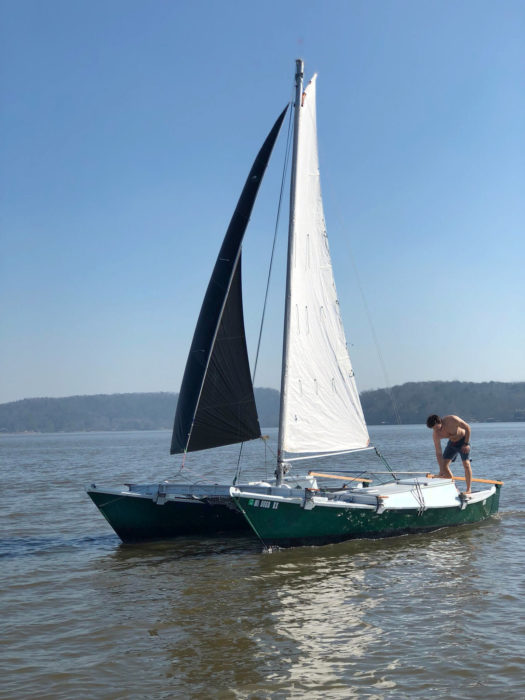 Dale Duke
Dale DukeWhile the Tiki’s main is designed to be sailed with a loose foot, the author finds an easily mounted, aluminum sprit boom provides improved performance in light air.
The hulls are built using the stitch-and-glue method, making it a fairly quick build, even for the first-time builder, though practicing with some scraps of plywood and epoxy is recommended for beginners.
Construction starts with forming the hull panels and stitching them together, then moves on to installing bulkheads and bunks and fitting the decks and cabintops. After the hulls are complete, just three beams, two tillers and rudders, and a wooden mast remain as the last major projects. For BETO, I chose an aluminum mast—a 22′ length of 4″ aluminum tubing with a 1/8″ wall thickness, as recommended in the plans. I chose aluminum over wood in hopes of a lighter mast that would require less maintenance and be easier to raise when rigging.
The Tiki 21’s most controversial feature is, perhaps, the use of lashings, rather than conventional marine hardware, to hold the amas and akas (hulls and cross beams) together. Wharram believes that the lashings allow for shock absorption and decrease shock loads at the joints. Each wrap of the five loops has a 2,800-lb breaking strength. The lashings are frapped so tightly that small movements between structural members are unnoticeable. The lashing system is proven by both Wharram cats and the well-traveled Polynesian voyaging canoes of the Pacific.
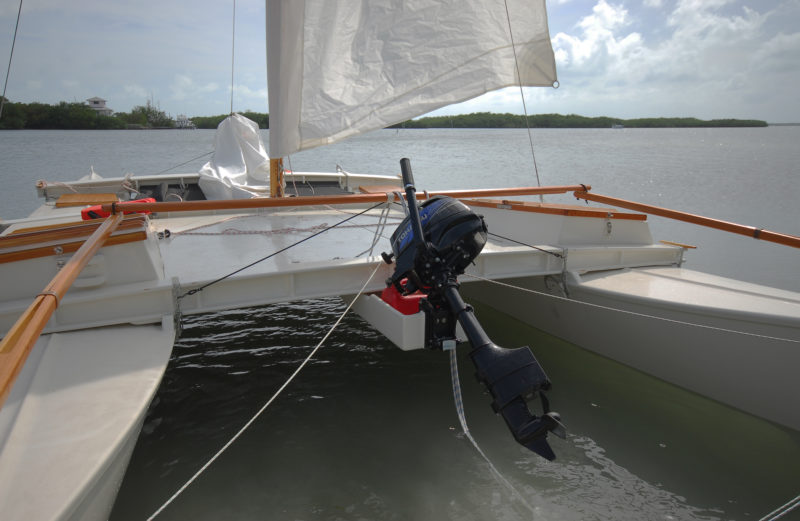 Scott Williams
Scott WilliamsThe Tiki 21 plans include a motor mount set within the perimeter of the deck. The pod added to this boat frees up deck space and includes a place for the gas tank. The cross beams, or akas, are stitch-and-glue I-beams.
The Tiki 21 was designed to be assembled on a beach at low tide and to float away when the sea returns. It has a 14″ draft, and each hull weighs in right under 200 lbs when completed. For our negligible tidal range and for freshwater sailing, I chose to build a trailer with telescoping sides that allow the hulls to be expanded outward for boat assembly before being backed down the ramp. We currently sail BETO on a small lake, so it rests on the trailer between outings.
When we want a taste of salt water, we unlash the beams and slide the hulls together for a package that is a little wider than my small Toyota truck. I can assemble the boat by myself in two hours and disassemble it in an hour. This is pretty fast to be on the water, and a helper could easily bring this time down as the lashings and frappings are the most time-consuming tasks. Some Tiki sailors have had good luck with ratchet straps and nylon webbing when trailering to daysail. I wouldn’t recommend ratchets in lieu of lashings for venturing offshore, however.
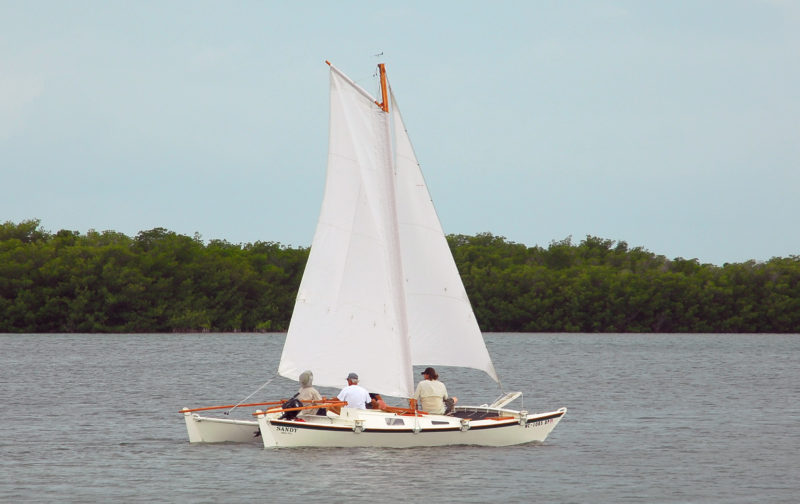 Scott Williams
Scott WilliamsThe Tiki 21 was designed with cruising accommodations for two, but there is room for more on deck. The catamaran has a carrying capacity of a half ton.
So how does the Tiki 21 sail? I’m a former racing catamaran sailor whose friends all sail go-fast boats, and I think it sails like a dream! The rig is a Wharram “Wing” sail that keeps the center of gravity low and the power high. The sail is modeled after a high-aspect Dutch gaff rig, using a short gaff at the peak and an elongated luff pocket that envelops the mast and minimizes turbulent airflow. This unique arrangement offers performance similar to modern rotating masts and square-top mainsails without all of the moving parts.
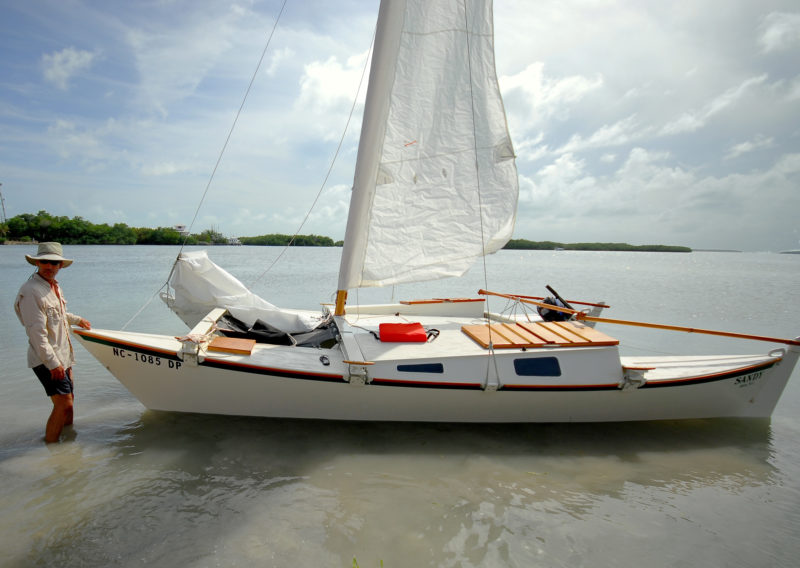 Scott Williams
Scott WilliamsThe mainsail is sewn with a luff sleeve for a smother flow of air around the mast. The jib and main halyards run along the mast inside the sleeve. This Tiki 21 was built by Rick Hueschen of North Carolina.
Unlike older Wharram designs, the Tiki 21 has a power-to-weight ratio that can get one in trouble if the wind pipes up. In light air, however, it is slightly undercanvased, and a drifter works wonders. The deep-V hulls have hardly any noticeable leeway if sails are trimmed correctly, and can tack in light and heavy air even sailing just the main.
The rudders are lashed to the sternposts and skegs and do not extend below beneath them, so the Tiki can’t turn on a dime in tight quarters. However, when sailing, it tracks like it is on rails. I sail upwind all the time in up to 20 knots with just a bungee crossed over the tiller. The Tiki is superbly well balanced and will sail along happily with proper trim. To windward we have seen 7 knots with the wind at 50 degrees true, falling down to around 5 knots at 40 degrees true. Off the wind, BETO has clocked 15 knots while power-reaching with no noticeable lifting of the windward hull (check my video). For normal cruising, we reef the main and jib in 15 knots to keep dry on deck and fully in control while still making 8 to 10 knots on a reach. For sails, we carry a main with three reefs, a jib with one reef, a nylon drifter, an asymmetric spinnaker, and a storm jib. I have an outboard, but I learned to sail on a 22’ engineless racing sloop, so I have plenty of patience when the wind dies, preferring not to deal with a nasty outboard and volatile gasoline. Using a stand-up paddle, I can move the Tiki all day at 3 knots in flat water, and with a second paddler it’s even faster.
 Dale Duke
Dale DukeWhile each hull provides room for a narrow berth, the deck provides more spacious accommodations when equipped with a canopy or a free-standing tent.
For coastal cruising on a small catamaran, one can really not find a better-suited vessel than the Tiki 21. The accommodations inside each hull provide a 12′-long bunk that is 2′ wide; the hulls span 3-1/2′ at the sheer. Our sleeping accommodations are often a two-person tent set on deck, or my girlfriend and I can get cuddly and sleep in one hull if needed. All of the bunks are above the waterline, and under them are the bilges, which provide loads of storage. The load capacity is listed as 1,000 lbs. The bows and sterns all have watertight flotation chambers. The anchor locker doubles as another flotation chamber. The Tiki 21 has six bulkheads in each small hull, making it a strong little boat. Resting between the akas is a plywood deck measuring 6′ x 7′ that never moves far from level when under sail. For my own preference I built a slatted cedar deck instead of a solid plywood one, and it has since been approved by the Wharram Design team.
Rory McDougall sailed his modified Tiki 21, COOKING FAT, around the world in the early 1990s, and until just recently he held the record for sailing the smallest catamaran in a circumnavigation. He experienced gales pushing waves up to 30′, and his boat suffered little damage. In 2010, McDougall sailed in the Jester Challenge, a single-handed transatlantic race for boats between 20′ and 30′, and came in second after 34 days under way, just a few hours after a larger monohull. When in storms, McDougall goes on his sea anchor and reports that the Tiki rides very happily and calmly. In his first gale on sea anchor, he even felt so relaxed that he tied a jibsheet around himself and jumped overboard to swim the swells!
The stories of COOKING FAT’s performance convinced me that a Tiki 21 would easily manage any conditions I’d be likely to encounter. If you’re looking for a small and easily managed coastal cruising catamaran to build, then I couldn’t recommend the Tiki 21 highly enough. In fact, it is my favorite boat I have ever sailed. For an adventurous couple with goals of gunkholing and cruising the coast, this vessel is simply what dreams are made of. The estimated building time is around 400 hours. I spread my time over about a year and a half and spent roughly $10,000. For my time and effort I got an outrageously capable, fast, safe, and well-mannered cruiser and daysailer. ![]()
Brad Ingram lives in Birmingham, Alabama, and enjoys sailing, running ultramarathons, and climbing. He spent eight years in 20th Special Forces Group on a small Intelligence team, and he’s now going to nursing school as a civilian. He plans to travel while working as a nurse, making it easy to spend a significant amount of the year traveling in the mountains or at sea. Among all of his recreational pursuits, sailing occupies the lion’s share of his enthusiasm and interest. He mostly enjoys small boat cruises and small, raid-type multihulls. He has a passion for simple, traditional vessels and enjoys sailing sport boats as well.
Tiki 21 Particulars
[table]
Length/21′
Beam/12′
Waterline length/18′6″
Weight/790 lbs
Load Capacity/1000 lbs
sail area/208 sq ft
[/table]
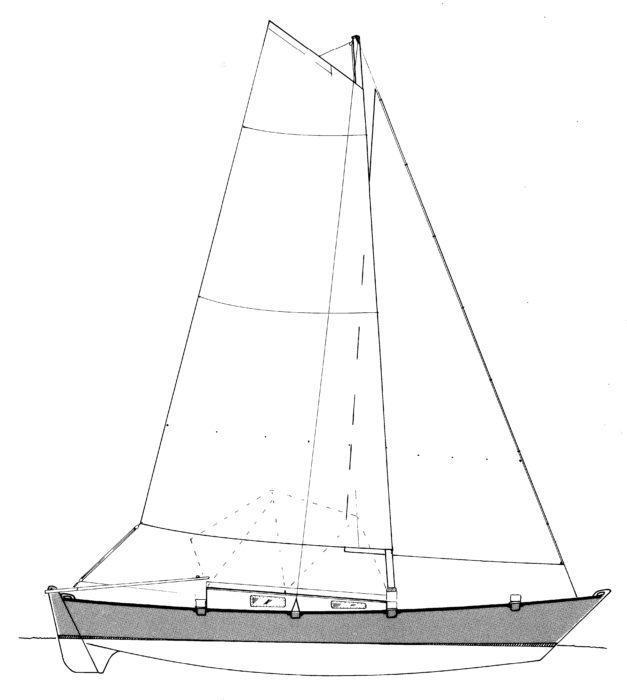

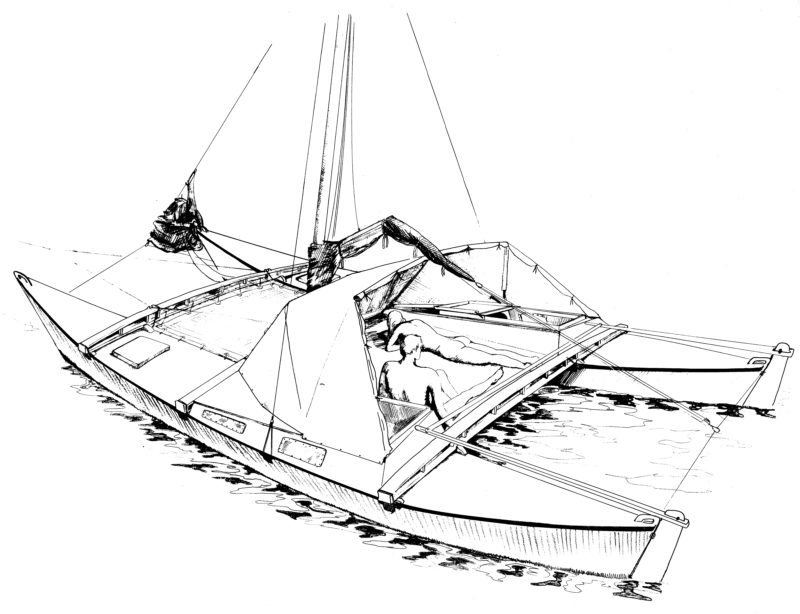
Study plans (£19.00) and full sets of plans (£505.00) are available from James Wharram Designs.
Is there a boat you’d like to know more about? Have you built one that you think other Small Boats Monthly readers would enjoy? Please email us!

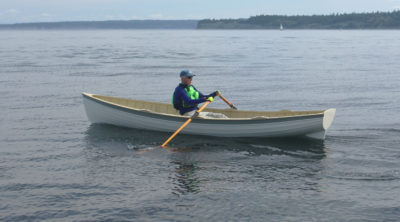

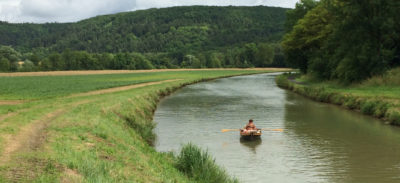

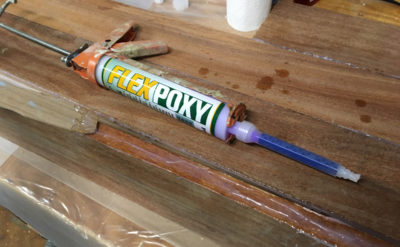
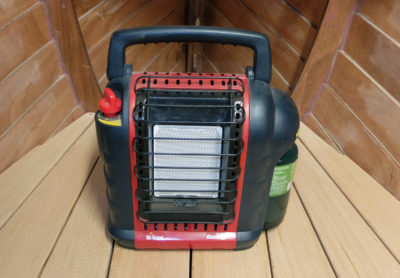
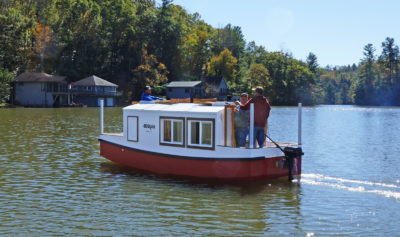
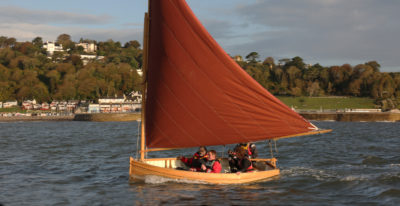
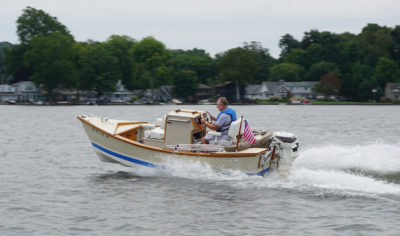
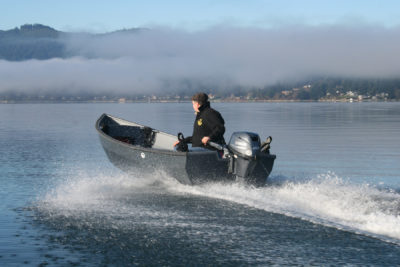
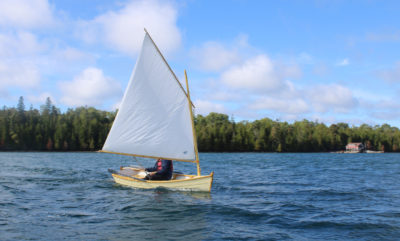
For anyone interested in seeing more Wharrams up close, there will be a Hui Wharram Sail-In in Fort Meyers on May 18 through 20th. I think SV BETO will be there as well. Details here.
Is the Hui sail-in still held in Ft Meyers? I live close to there and would love to see some homebuilt catamarans!
The book is also available as a Kindle edition.
Editor
Merci pour toute ces informations sur Tiki 21.
(Thanks for all this information about the Tiki 21.)
Thank you for the article. Isn’t there a second pair of shrouds in the design?
Why do you bother with an engine and all the paraphernalia attached to it, starting with the pod? Do you feel a stand-up paddle is faster than sculling a sweep? I am planning to use a sweep on my Tiki 26. I used to move my 35′ engineless steel cutter up to ¾ to 1 knot with a self-made 16′ oar. I never had an engine on my Shark 24.
Do you think a ply platform might be structural and reduces the torsion leading to a slacker stay? I am planning to test the Tiki 26 without a platform, only netting, à la Cookie.
Sorry to just get back to you. The white boat is not mine. BETO is the green one with no motor. The platform is in no way structural, and I just like the SUP paddle as it goes right into action and I do a lot of paddling with the same motion for exercise.
I really like your engine mount. I’m almost finished building my Tiki 21 and don’t like the idea of stinking old engine sitting up in the middle of the deck and sleeping/lounging area. So I think I’ll copy you. Anything I need to be aware of? Could you send other photos that explain your system more clearly.
Many thanks,
Tom
How wide are the hulls ???
Does anyone know of a Tiki 21 in the NW US? Washington, Idaho, Oregon? I have built kayaks, sailed small boats, and really like what I see in the Tiki 21 but would like to sail one, or at least see one in person, before committing to a year of building.
Thank you!